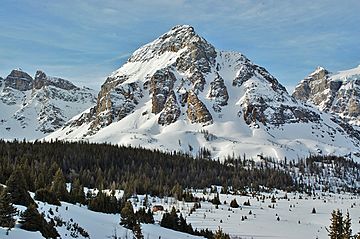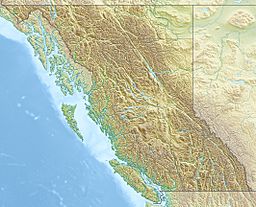Naiset Point facts for kids
Quick facts for kids Naiset Point |
|
|---|---|

Naiset Point
|
|
| Highest point | |
| Elevation | 2,755 m (9,039 ft) |
| Prominence | 45 m (148 ft) |
| Parent peak | Mount Assiniboine (3616 m) |
| Geography | |
| Location | British Columbia, Canada |
| Parent range | Canadian Rockies |
| Topo map | NTS 82J13 |
| Geology | |
| Age of rock | Cambrian |
| Type of rock | sedimentary rock |
| Climbing | |
| First ascent | 1920 H.E. Bulyea, N. Allen, M. Gold, D.J. McGeary, J. Stewart, E.L. Tayler, C.G. Wates |

Naiset Point is a mountain peak that stands 2,755-metre (9,039-foot) tall. You can find it in Mount Assiniboine Provincial Park, which is part of the Canadian Rockies in British Columbia, Canada. This mountain is about 1.0 km (0.62 mi) southeast of Lake Magog. It sits at the end of a ridge that stretches north from Terrapin Mountain.
Naiset Point is made of sedimentary rock. This type of rock forms from layers of sand, mud, and tiny bits of plants and animals that settle over time. The rock here was laid down during the Cambrian period, which was a very long time ago. It formed in shallow seas. Later, during an event called the Laramide orogeny, this rock was pushed eastward and moved on top of younger rock layers.
The Story Behind Naiset Point's Name
The mountain was given its name in 1913 by a group called The Interprovincial Boundary Survey. They chose the word naiset because it comes from a First Nations language and means sunset.
The very first time people climbed to the top of Naiset Point was in 1920. A team of climbers, including H.E. Bulyea, N. Allen, M. Gold, D.J. McGeary, J. Stewart, E.L. Tayler, and C.G. Wates, made this first ascent.
The mountain's name officially became recognized in 1924. This happened when the Geographical Names Board of Canada approved it.
Weather and Climate at Naiset Point
Naiset Point is located in a subarctic climate zone. This means it has very cold winters with lots of snow. The summers are usually mild. Temperatures can drop below −20 °C. With the wind chill factor, it can feel even colder, sometimes below −30 °C.
Any rain or melting snow that falls on Naiset Point eventually flows into Lake Magog. This process is called precipitation runoff.



